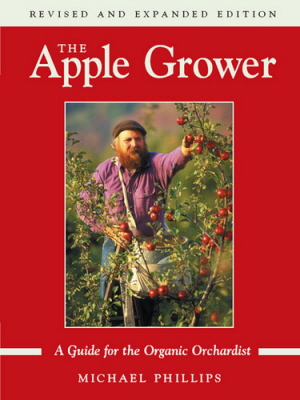Updated: November 26, 2020
E very specialized area of gardening has its own preeminent guide book. For growing apples organically, it’s The Apple Grower, the classic guide written by Michael Phillips.
Although written primarily for the professional orchardist, backyard apple growers can learn a ton from this book.
You may be thinking about buying your first apple tree from Wal-Mart, or you may have several cultivars on M111 rootstock from Fedco.
In either case, beginner, expert or somewhere in between, there’s something to be learned from this master orchardist’s deep experience growing apple trees.
This is especially true for anyone in the U.S. trying to grow apples organically EAST OF THE ROCKY MOUNTAINS. Most knowledgeable people would agree that growing apples in the East is more difficult because of the native insects.
Michael’s Lost Nation seven-acre orchard is in Northumberland New Hampshire, so he has a wealth of experience with challenges facing apple growers in the East.
Let’s take a sec to get the legal words out of the way. This article may contain affiliate links. That means if you click and buy from my partners, I will make a tiny amount of money at no cost to you. This in no way affects my recommendations.
Reading The Apple Grower is time well spent
Before sitting down with this book, understand that the author’s writing style is a bit unconventional and sometimes requires you to re-read sentences before you pick up on the true meaning. Still, it’s worth the investment.
Michael is knowledgeable about the golden days of apple history, around the time of the U.S. revolutionary war. As a result, he combines apple growing techniques from the past with the best of modern technology.
Here are some of the things you will learn if you read The Apple Grower:
- What varieties are available (including heirloom apples), and when do they bloom.
- How and what to use for mulch under your trees.
- What are all the different insects that can cause trouble for your apples and how best to deal with them. This book helped me confirm that plum and apple curculio are my most troublesome pests. Here’s how I’ve been using footies to deal with curculio.
- How much to thin out your apples at the beginning of the season and why you’ll get more and better apples if you thin properly.
- What cover crops can help enrich the soil for apple trees and how much compost is necessary.
- How to identify apple trees you’ve inherited from previous land owners, and how to decide if you should try to restore them to apple production.
The last organic frontier
Phillips doesn’t make organic apple growing sound easy. The complexity of the apple tree ecosystem is dizzying.
By his count, there are over 500 species of insects and 100 disease organisms found in fruit orchards.
Phillips calls apple growing the last organic frontier because, at least in the Eastern U.S., it has yet to be conquered. That’s why you’ll meet many apple growers at farmers’ markets and orchard tours that will tell you it’s just not possible to grow organic apples profitably. The challenge is too great.
The Apple Grower: A Guide for the Organic Orchardist helps you meet the challenge in your backyard.
Related articles that might interest you:
- Growing Organic Apple Trees, Part II
- Growing Organic Apple Trees
- My Pruning Apple Trees Mistake
- Pruning Apple Trees, a Step by Step Guide
Suburban Hobby Farmer is a participant in the Amazon Services LLC Associates Program, an affiliate advertising program designed to provide a means for sites to earn advertising fees by advertising and linking to amazon.com.
